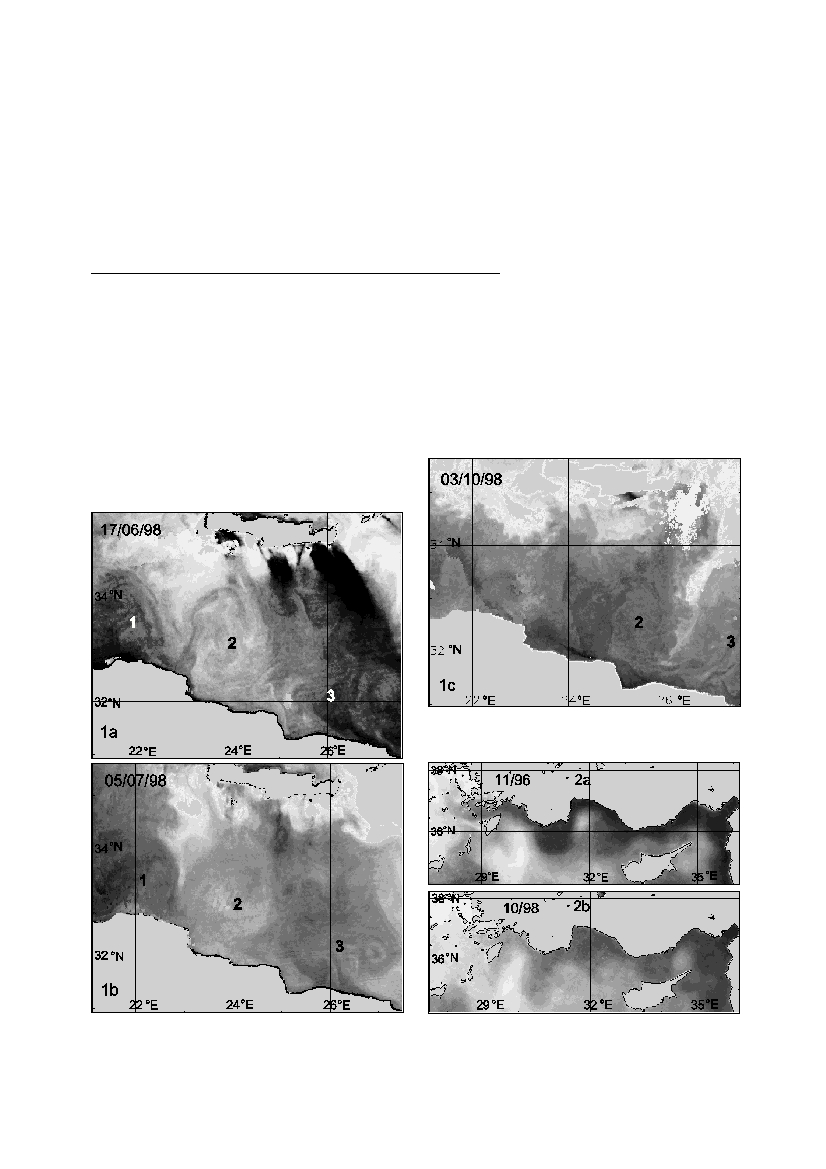Rapp. Comm. int. Mer Médit., 36,2001
67
Infrared images are extremely efficient in monitoring mesoscale eddies
for periods up to several years. The Eastern Mediterranean has been
described as "nearly full" of eddies, but whether some of these eddies are
permanent or transient features has never been fully addressed. It is all the
more important since many of the eddies considered as permanent in the
literature are pivotal features of the widely accepted general circulation
scheme [1].
We have analyzed NOAA/AVHRR images [2] of the Ionian and
Levantine basins over the period 1996-2000. Examples are illustrated in
figures 1 and 2, and these analyses will be presented in detail.
Preliminary results show that (anticyclonic) eddies commonly have life-
times exceeding 1 year (sometimes up to 3 years, as in the Algerian Basin
[3]). Some can remain motionless for periods > 6 months, and/or propagate
at low speed (~1-2 km/day), hence look misleadingly "permanent".
The mesoscale features show similarities with the ones observed in the
western Mediterranean, where many complementary measurements have
been collected. The mesoscale eddies displayed in figure 1 resemble those
described in the Algerian Current, and the meanders displayed in figure 2
resemble those described in the Northern Current. We can thus infer with
reasonable confidence that such mesoscale features result from the insta-
bility of an alongslope ?ow.The overall impression is that the surface cir-
culation is mostly alongslope and continuous from Libya to Turkey.
References
1- Robinson, Golnaraghi, Leslie, A
r
t
egiani, Hecht, Lazzoni, Michelato, Sansone,
Theocharis and Ûnlüata, 1991. The eastern Mediterranean general circulation:
features, structure and va
r
i
a
b
i
l
i
t
y.Ì21 Dyn. Atmos. Oceans, 15, 215-240.
2- German Aerospace center DLR: http:// isis.dfd.dlr.de. Provides daily to
monthly composites.
3- Puillat, Taupier-Letage and Millot, 2000. Algerian Eddies lifetimes can
near 3 years. J. Mar. Systems, in press.
A PRELIMINARYANALYSIS OF THE ALONGSLOPE CIRCULATION IN THE
EASTERN MEDITERRANEAN AS INFERRED FROM INFRARED IMAGES
N.Hamad*, C.Millot and I.Taupier-Letage
LOB/CNRS COM, Antenne de Toulon, La Seyne, France - nhamad@ifremer.fr
Abstract
In continuation of the work in the Algerian Basin, thermal patterns of NOAA/AVHRR images have been analyzed in key-areas of the
Eastern Mediterranean to clarify some surface circulation features. The mesoscale structures (filaments, meanders and eddies) observed
all along coastlines from Libya to Turkey are interpreted as the manifestation of a surface circulation which, at least during the period stud-
ied (1996-2000), was mainly alongslope and markedly unstable.
Keywords: Eastern Mediterranean, circulation, mesoscale phenomena, remote sensing
Figure 1: Daily composites of the Cretan Passage. Eastward alongslope
propagation of three eddies. Showed (a) on 17/06/98, (b) on 05/07/98 (pro-
pagation speed is low, so that at a 19-day interval translation is hardly
Figure 2: Monthly composites of the Northern Levantine Basin.
(a): Nov.1996, (b): Oct.1998. The warmer (darker) signature of
the coastal current is continuous from the Syrian to the Turkish
coasts, and meanders. (Partial) continuation of this current

